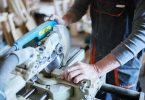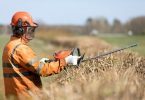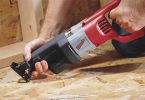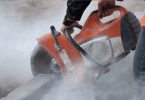When it comes to home renovation things get messy, especially when you work with tiles. Most wet tile saws used by professionals around the country tend to make a lot of dust particles spreading all over the working space. But it was a different story for me as my father was a superb DIY enthusiast who always kept the top-of-the-line power tools in the house. So, I was lucky enough to find one of the best tiles saw for the money of the time when I needed to fit tiles on my kitchen wall.
Depending on the tile material you may need a saw that not only rolls over super smooth on the tiles but also takes care of the edges making sure they don’t get cracked. The market is littered with hundreds of models of this particular tool, it’s pretty easy to get confused. This is why I’m taking this opportunity to share an elaborate research work on the top deals of the market, so you can make a better decision.
Top 10 Tile Saws That Provides Great Value for Money
In the following section, we’ve tried to answer that question. Spoiler alert, there’s no single best choice that would meet everyone’s requirements. Read carefully to pick yours.
01 DEWALT Wet Tile Saw D24000S (Editor’s Choice)

Considered as the best of wet tile saws, the DEWALT D24000S is preferred by most hard-core professionals for versatile work projects. Once you have it, you’d never need to look outside, I’ll tell you why.
Let’s find out what the package comes with. You’ll get the main saw body, a diagonal body, an extension guide, a rolling table, a pump, a Dewalt XP4 cutting wheel, a saw raking system, required screws, bolts, and a stand. The assembling is super simple and it wouldn’t take more than one person to assemble the whole thing.
This 69-pound. the saw has the capacity to do 25 inches rip cut and 28 inches plunge cut. It contains an indicator for the cut line so you can maintain accuracy. The steel roller is handy, ensuring stability and confidence. It is a compact package with high portability. It takes a lot less space in the car if you order the parts separately. It comes with a 3 years limited warranty coverage.
We were able to achieve 1/32” over 18” cuts effortlessly, thanks to its 1.5 HP motor. We rolled a diverse group of tile materials to check if it could stand up to their hardness, and it just blew our minds with its performance. The plunge cuts could be made using one hand. The spring system would always keep the blade up when not being used.
We liked how easy it made for us to get the angled cuts as we found that it had a 45 degrees and 22 and a half degree bevel that could be controlled by a locking system. We also liked how sturdy the build quality felt. The rail never wiggled or moved side to side.
Another point we liked about the design was its water containment capacity. It could hold 5 gallons of water. The quality of the water nozzles was good and both of them were positioned in the right position. The blades could easily go through glass, marble, and natural stone materials without making any chips or nicks.
Now you know why this product is a top-rated one. Every single component coming with the package is of quality material. The ergonomic design and efficiency truly call out for a justifiably high price point. So, even though it has a high price point compared to other products on our list, it remains our top choice.
Pros
- Unmatchable ergonomic design
- Superb performance
- Sturdy and Durable
- Simple to maintain
Cons
- Poorly written assembly manual
Our Verdict
DEWALT is a common household name for most American DIY enthusiasts. The reason they earned their fame is the superb engineering they put behind each of their production tools. In this particular product, they successfully blend mechanical excellence with ergonomics. We considered tons of aspects before putting it on top of our list and it successfully stood out in all of them. If you have the budget and are looking for a quality wet tile saw for the money, we highly recommend this one for you.
02 SKIL 3540-02 7-Inch Wet Tile Saw (Budget Choice)
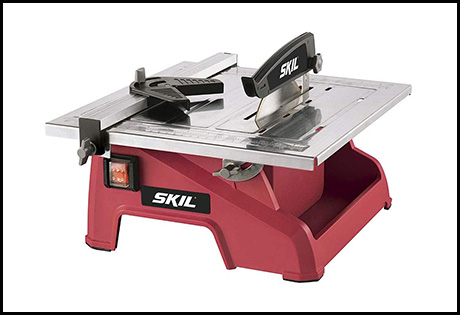
Not everyone needs a professional-grade heavy-duty tile saw for small DYI projects at home. For those who are looking for a smaller package without compromising the quality of performance, we have SKIL’s 7 inches red 3540-02 model that is not only pocket friendly but also a performer!
You are going to get a superb performance from this little buddy of yours. The stainless steel tabletop can house tiles that are 12” X 12” in size at best. The wet saw has all the useful features you’d need for smooth cutting. For example, the rip fence is adjustable, there’s a miter gauge ensuring accurate miter and straight cuts. The water reservoir ensures efficient blade cooling simultaneously reducing the spread of dust particles. When under zero load the blade can spin at a rate of 3600 RPM. It can do 7.75” and 7.25” cross and diagonal cuts respectively.
We were amazed to be able to achieve up to 45 degrees of bevel cuts on stone. The blade cooling system appeared okay with no overheating issues. Under a hundred bucks, we didn’t expect SKIL to provide a blade in the first place, but it did! We threw porcelain planks, cement concrete, standard ceramic, glass subways, and stones at it and we’re pretty happy with the result.
The price-to-quality ratio is the reason it’s widely popular and has the highest number of user reviews on eStores. The pricing is the lowest among all other items on our list. However, the overall build quality might not be on par with a premium model and at this price point, you can’t really expect something cutting through thick marble plates like a pro!
Pros
- Low price point
- Highly portable
- Amazing cutting capacity
- Easy to clean
- Good performance
- Reliable
Cons
- Can’t go through super hard tile material in a straight line
Our Verdict
If you are looking for a budget tool that offers a good bang for the buck, SKIL 3540-02 has no alternative as the time. For this one, you get more for what you pay for. This amazingly portable tool is ideal for small projects for which you wouldn’t need a professional arrangement. Got to replace your bathroom tiles yourself and don’t want to spend a fortune? Just get it without a second thought.
03 SKIL 3550-02 7-Inch Wet Tile Saw (Beginner’s Choice)

One of the key selling features of SKIL’s 7-inch 3550-02 model is its HydroLock system which means it contains water and dusty mess effectively. So, it performs super clean and you can cut your tile in the same place where you are installing. The simplicity of operation and clean functions set it to be an ideal saw for beginners.
With the package, you will get a 7” diamond blade, a blade ranch, sliding side extension, miter gauge, and a rip fence. This tiny saw weighs only 24 lbs with dimensions of 22” X 18 X 8.5”. The electrically powered saw unit has a solid frustration-free metallic build. It supports up to 18” X 18” tile size.
When testing the product we were amazed by how clean it functioned. The HydroLock system does what it says on paper. We were exposed to minimum mess while working. Moreover, it was super easy to use and clean. The pricing was also within an affordable range, making it an amazing option for beginners. The bevel and the sliding side extension slide smoothly.
Pros
- Lightweight and portable
- Hydrolock system makes it dust and mess-free
- Decent working capacity
- Mini design
Cons
- Not compatible for heavy and large projects
Our Verdict
SKIL has done a good job here by achieving the golden ratio of performance and price. Given the price point, you can’t expect a heavy-duty performance by this product. But in terms of usability, this is a performer. You can easily fix hundreds of square feet tiles using it. Just make sure the tile material is not super hard.
04 DEWALT DWC860W Masonry Saw (Best Handheld Model)

Handheld tools are preferred by many people for their diverse applications. You can literally make any type of angled cuts in any type of working environment using them. We chose DEWALT DWC860W for its amazing performance, ergonomics, and capacity. You can’t really go wrong with this tool given that it offers all the features an ideal handheld saw should have.
With a 10.8 AMP powerful motor the DWC860W can smoothly go through any hard tile material. It packs a 4-3/8? diamond blade which is supposed to be among the toughest blades on the market. You can use this with or without water spray. However, it’s recommended that you use water for enhanced performance and longevity of the blade. The versatile tool will allow you to get 45-degree bevel cuts. For heavy-duty operations, it offers a lock-on button.
We didn’t have any problem rolling the tool on porcelain, granite, glass, and marble. It tackled all of them pretty smoothly. Another thing we liked about it was the 13-foot stock water pipe it came with. The motor performed consistently and reliably all through the testing session. The rubber hand grip felt good in hand. DEWALT knows how to make their tools user-friendly and this time they’ve proved it again.
It enjoys the same number of ratings as the previous SKIL model with less number of reviews. However, for handheld models, this one enjoys the highest number or ratings and reviews on Amazon. In terms of price, it’s a lower mid-range product. DEWALT offers a 3-year warranty coverage.
Pros
- Powerful motor ensuring 13000 RPM max rotation speed
- 13 feet waterline
- Lock-on button
- Rubber grip
Cons
- The water valve is made of cheap plastic
Our Verdict
DEWALT is a common household name for many Americans. They’ve been able to flaunt their mastery once again in this little power tool. In case you have a problem with the water valve, just replace it with something better. If you are looking for a handheld unit for cutting hard tiles, you won’t regret getting the DWC860W for sure.
05 HYCHIKA Compact Circular Saw Tile Saw (Compact Choice)

We didn’t have a plan for creating a compact category for this type of power tool, but when we came across HYCHIKA’s Circular Saw and its numerous features, we had no choices left. It’s full of useful features yet coming at a surprisingly small frame. The color and graphical design, rubbery grip blade design, and most importantly the performance of the motor are impressive. Most importantly, the price is just too attractive.
You are going to get quite a few things extra with this one– the main saw body, one HW 30T blad, one HS 36T blade, one diamond blade, hex key, metal guide, exhaust pipe, storage bag, and obviously the user manual.
The 4 amp motor has a 4500 RPM cutting speed that is sufficient enough to get through wood, tiles, plasterboard, and PVC. For extra safety and durability, it has a high-quality iron wraparound along with a metal upper cover. The 6.45 lbs. machine also packs a laser guide helping it to maintain a straight cutting line. For ensuring quick and precise cuts it houses a parallel guide extension. It also sports a depth gauge lever so you can adjust the cutting depth within the range of 0-25mm.
We were amazed at how fast it could cut through wood, tile plates, and aluminum boards but without making any mess. The designers took care of installing an effective dust management system so it superbly ensured a clean work environment.
Apart from that, we liked its safety features for the switch. It’s made to be used with one hand, so we were able to use the other hand for securing the cutting material. We got some smooth and precise cuts out of the machine, no wonder why it is one of the highest-rated tile saw on our list.
Pros
- Powerful motor with max 4500 RPM (no-load speed)
- Depth adjustment features
- Laser guide
- Rubber handle
- Effective dust management system
Cons
- Cutting wouldn’t be smooth on hard tile material
Our Verdict
First of all, do not forget the price of this product. For the price, it is absolutely a great saw with numerous useful features. It should be ideal for small DIY projects. If you are looking for a compact model under 55 bucks, you cannot really go wrong with this one.
06 MK-370EXP 1-1/4 HP 7-Inch Wet Cutting Tile Saw (Professional’s Choice)

The reason we ranked this product into the professional category is mainly because it packs features that professionals would like better. This doesn’t mean our first choice isn’t a professional model. MK-370EXP is one that professionals would prefer more while the DEWALT D24000S is more of a universal choice that even an amateur worker can handle.
MK-370EXP is a heavyweight model (like the MK470) with 33 lbs of weight (in total) and dimensions of 35” x 22” x 16”. It is engineered for cutting mainly porcelain, marble, and ceramic tiles. It houses an aluminum sliding table that allows 18 inches length of cut and 13 inches diagonal cuts.
What we liked about the 1-1/4 HP motor (less powerful than that of Mk-880) was its maintenance-free gearbox assembly. The play capacity of the saw came out to be 7 inches and it could go 2 inches deep into the tiles, enough to handle large projects.
We were able to perform both plunge and miter cuts. It beveled up to 45 degrees. One of the professional-grade features of the machine was its water cooling system. It had a built-in water distribution system that sprayed water from both sides of the blade, keeping it effectively cool throughout the working session.
Pros
- Consistent performance
- Portable and lightweight
- Both plunge and bevel cutting options
- Efficient water system
Cons
- Water nozzles not adjustable
Our Verdict
It’s true we expected higher performance from an MK power tool as they are well known for their quality. This one held up to that trend and we were happy with what it could do especially considering its price. It can withstand professional demands and you can totally give it a shot. The same motor of this device is suitable for MK’s 470, 370EXP, 377, and 770 models, so you have replacement options.
Other MK models that might interest you: MK 170, MK 145, MK 212, MK 101, and MK 660.
07 PORTER-CABLE PCE980 Wet Tile Saw
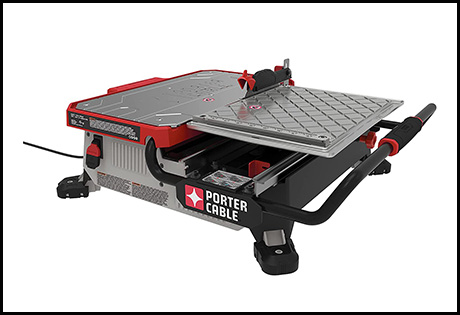
If you are looking for a mid-range tabletop wet tile saw then PCE980 by Porter-Cable might be an ideal choice for you. It sports a stainless steel tabletop, a cast-metal solid sliding tray with channels for water flow, a handy rear fence, and a satisfactory cutting performance with a dedicated carry handle.
The package comes with the PCE980 body, porcelain 7? tile blade, blade wrench, and a miter square.
First of all, we liked the build quality of this 32-pound tool solidly built for optimum cutting experience. The motor was good, the tray was sturdy. We liked the positioning of the miter square. It helped us get smooth and repeatable rip cuts. You can cut any type of tile up to 12 to 24 inches.
The adjustable rear fence came out real handy when choosing different tile sizes. The water management system was terrific. The finish of the cutting also impressed us a lot. It went through glass, marble, and ceramic workpieces without any broken edges.
However, it scores high ratings and over a hundred reviews on Amazon. But for us, it was a great piece of machine and we were happy with every aspect of it except for the stock blade that came with it. You can surely change the blade anytime.
Pros
- Solidly built
- Portable
- Effective water flow and guard system
Cons
- The sliding table wiggles a bit
Our Verdict
This one is a legendary Porter Cable product with a fantastic performance. You can’t really go wrong with it. It will surprise you with how efficiently it handles different kinds of tough materials. We highly recommend this one for home or factory use.
08 QEP 22400Q 3/5 HP Torque Master Tile Saw
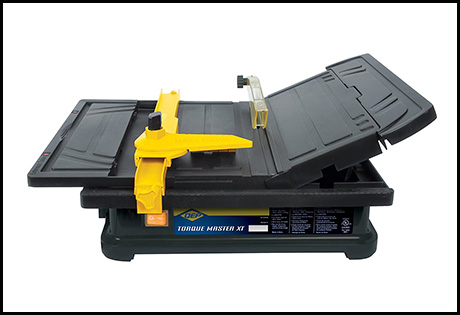
This is another affordable tile saw that comes with all the standard features. Initially, we didn’t want to add another low price model to our list, but this one impressed us a lot and we just couldn’t find a good reason to exclude it. Here is the deal, despite being an inexpensive model, it cuts through ceramic, stone, and marble plates like a pro. Let’s find out what else it offers.
With a 0.6 HP hi-torque motor, it doesn’t have any difficulty in cutting hard materials. We liked the dual extension tables it came with which allowed an extra five inches working surface. If you want to apply porcelain or any harder tiles on it, the manufacturer recommends their #6-4008BW blade (Black Widow).
We could fully adjust the miter guide which included QEP’s distinct ratchet mechanism. They used a lot of plastic materials here. Many prefer plastic for its non-corrosive quality. Since it deals with water, there’s no chance of growing water mineral deposits in a hundred years. We liked that they used high-quality plastic for this unit.
Pros
- Lightweight and highly portable
- Affordable
- Cuts through most materials
- Effective water management system
Cons
- Too much plastic
Our Verdict
Not every working condition allows for big tile cutter machines. We often have to use smaller and portable ones for saving space and energy. For those situations, QEP’s 22400Q model is a great choice. It can be cheap and small, but it bites super hard. In a nutshell, it’s a mini powerhouse for sale. Make sure you get one if that kind of need arises.
09 QEP 22650Q 650XT 3/4 HP 120-volt Tile Saw
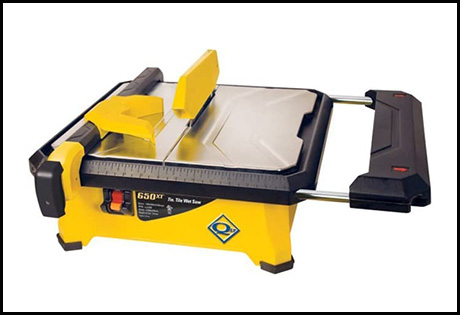
Just like the former model (22400Q) QEP did a good job in designing this slightly more expensive 22650Q model. The motor capacity remains the same– ¾ HP which can achieve up to 3 thousand 6 hundred RPM.
There’s a difference in the work surface between the two. They have added a durable stainless steel frame and working table to this commercial model for withstanding heavier loads. The footpads are rubberized for added stability. They also included an eight inches table extension for supporting large tile sizes.
We liked the stainless steel work table that added sturdiness to the tool. It has become more stable and durable than QEP’s 22400Q model. We were able to achieve smooth diagonal and rip cuts. We don’t really have much to complain about its 7 inches diamond blade. It worked just fine slitting sturdy materials.
In short, this is an affordable product ideal for beginners.
Pros
- Reliable build quality
- Lightweight and portable
- Smooth cuts
Cons
- Noisy
Our Verdict
Visibly QEP added some good features to 22650Q that were lacking in their 22400Q model. For that reason, the price crossed the hundred-buck mark, a bit more even. Yet, you get what you pay for. With improved build quality you can expect more from this machine.
10 Chicago Pneumatics 2.5 Horsepower 10″ Industrial Tile/Brick Saw

The last but not the least model is a reliable tile saw from Chicago Pneumatics. If you are looking for a powerful professional-grade model that is built to last, this one will hopefully get you through the test of time.
The head of this tile is designed to pivot in 45 and 22.5 degrees. This will help you achieve all the necessary angle cuts. The 15 amp motor power motor has a thermal overload protection system and the sealed bearings are protected from external dust and water damage.
We liked its solid build quality and straight cutting capacity. We were able to cut 18” long tiles without any problem. It is designed to house 12 inches diagonal cut which is a standard feature in this category.
What we liked about the product was its low vibration functioning. Thanks to its heavy-duty column made of cast alloy. The steel frame is large enough to hold workpieces in the right positions.
This product might not have the highest number of ratings and reviews when compared to our top models, we found it to be an impressive performer. Once you work with it, you’ll find it hard to do without it.
Pros
- Affordable
- Durable build
- Less vibration
- Easy to clean
Cons
- Poorly written user manual
Our Verdict
Make sure you get a good blade to work with this. That could change the game for you. One of the key selling points here is offering flagship-level features at a mid-range price tag. If you use a quality diamond blade with this, you might not find any difference in the result from that of a flagship model.
Tile Saws Buyer’s Guide: Key Features to Look For
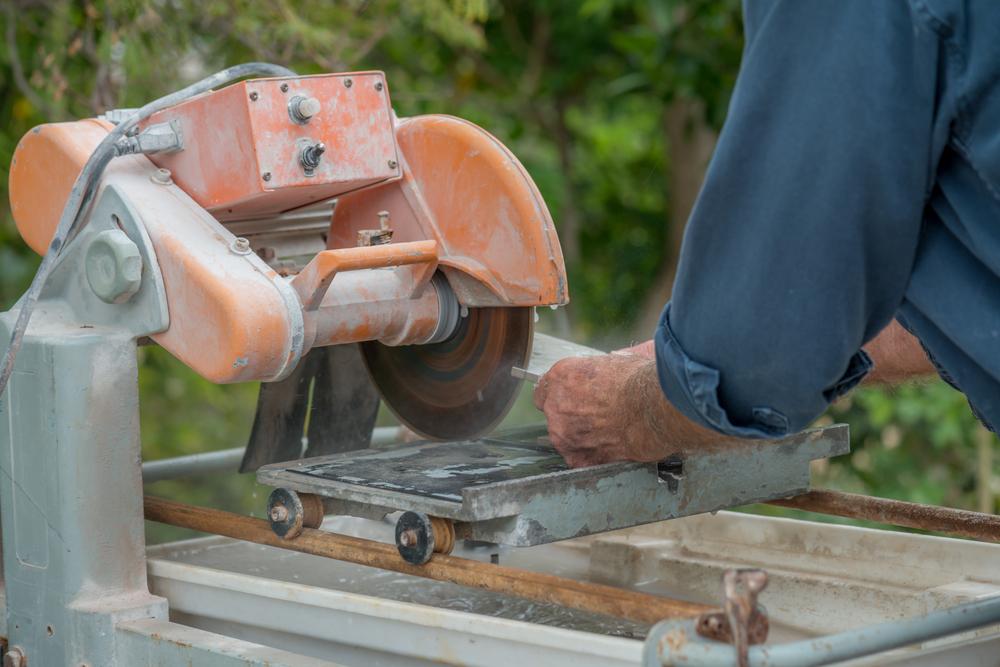
Choosing a power tool has the biggest impact on a working project. A wrong tool can reduce work efficiency and finishing quality. They also consume more time. You wouldn’t want to use a less efficient tool for a project that deals with expensive materials. That could waste a lot of money. A right tool not only ensures fast and smooth results but also helps save money and the environment. Besides, hard tiles produce tons of dust that is not healthy if not properly housed by the machine. Make sure you wear protective glass and face masks before working with this machine.
Here are some vital points to keep in mind when planning to buy this tool.
1. Power
These are typical electric machines using simple motor mechanisms to rotate blades for getting cuts. The power of the motor plays a vital role here. However, you should not be fooled by the power of the motor because you will find models packing highly powerful motors but delivering a way less smooth finish than those with less stronger motors. It’s mainly because of proper tuning, consistency in power delivery, torque-speed and building materials.
2. Cut quality & accuracy
The quality and accuracy of cuts depend on the matching of the cutting material and the quality of the blade being used. Also, the motor rotation speed and power decide how consistent the cut would be. Make sure you use diamond blades for consistent performance with all tile materials. The position of the blade matters here too. Continuous water flow ensures smoother cuts as water molecules wash away dust particles instantly.
3. Types
Tile saws can be primarily divided into two basic types—Wet and Dry.
-
Wet
In Wet category, the cutting blade is soaked with sufficient water for smoother and flawless cuts. Water keeps the blade cool and works as a lubricant. These models are simple to use and even a novice can achieve professional-level accuracy working with a wet machine. Water creates a dust free working environment keeping the working space dustless and tolerable. Wet saws are of two types— ones containing re-circulating pumps, the other ones don’t have pumps.
- Recirculating pump variety: These saws house water reservoirs from which water is used and reused upon filtering. So, you wouldn’t need to hook it up to a tap or faucet.
- Pump-less variety: These don’t have a reservoir of their own, so a water source is required for constant fresh and clean water supply.
- Dry
On the other hand, dry or waterless saws require skilled workers and they are mostly handheld. You’d need multiple pauses during work as the blade gets hot when making deeper cuts for some time. Make sure you use them outdoors as these will create a lot of mess.
-
Handheld
Handheld models are for lighter projects where the cutting materials are thin. They come very handy at times where mobility is necessary. There are both wet e if not used for quite a whileand dry handheld models available on the market. For the wet handheld models, you would need to attach a water hose to them.
-
Tabletop
Tabletop models are wet models where a table frame is used for convenient cutting. They offer a bigger working surface to put tiles for smooth and fast cuts. They can have a fixed blade, sliding tray or overhead rail designs.
- Fixed blade design: Here you would need to push the cutting material towards the blade.
- Sliding tray design: Sliding tray design has a built-in tray for putting your tiles on. It slides towards the blade.
- Overhead rail design: This model has a movable blade. So, you’d be rolling the blade on the tiles.
4. Blade type
Blades for these machines are of mainly 2 types– Wet blades and Dry blades. As you can understand, wet blades are for wet saws and dry ones for dry saws. Wet blades are made of super sturdy materials often using diamond parts for cutting stones, marbles and glasses. On the other hand, the dry blades are comparatively less sturdy. Apart from round shapes, you’ll find oval oscillating blades for oscillating tile cutters.
5. Blade capacity
This refers to the depth that the blade is able to reach when cutting. The standard blade (diamond) sizes are 7”, 8”, 10?. There are smaller (4 inches) blades available for smaller machines.
- A 10-inch disc can go up to 2.6? of depth into the tiles
- On the other hand, the 7 inches diameter blade will be able to cut 1.5 inches deep
- The 8? blade should go up to 2?
Make sure you choose the top-quality blade for your saw. The smoothness of the cut depends a lot on the quality of the blades.
6. Feed rate
Feed rate ensures the optimum circulation of the blade when in action. If you work on different tile materials, make sure you choose a machine that has an adjustable feed rate. For a single material, a fixed feed rate is preferable.
7. Portability
It’s a great feature to look for in a tile saw. Usually, it’s a heavy machine and requires a good amount of strength to drag around. Besides, we often require to move the machine in a convenient working space for you can’t move the entire pile of tiles easily. Well-known manufacturers tend to attach wheels for making them portable.
8. Versatility
Versatility refers to the spectrum of tile materials a single saw can cover. Professional-grade models are by default versatile in action. Versatility also refers to the features that allow different cutting angles and positions. A good model would let you cut different types of materials, but also, you’ll find multiple-angled cutting options.
9. Build quality
One of the vital points for any power tool is the build quality. These are heavy-duty equipment just like band saws or cabinet table saws and are applied on rock solid materials. The build quality must be good. However, manufacturers often compromise on build quality in a bid to achieve a competitive price point. Make sure you take care of that.
10. Tile size
The size of the tile matters because it must be on par with the saw’s blade size and motor capacity. If the tile is more than 2.5 inches thicker, you’d need a minimum 10 inches blade. Also, shaping the tiles requires specific angled cuts. That can be attained only when you have an advanced model in hand that allows you to play around with your tiles using bevels and angular rails.
11. Water source
The source of your saw’s water feed largely depends on what type of saw you are using. Sliding table models have a built-in water reservoir underneath the working surface from which a pump will draw water to soak the blade. Make sure you check the water sprayer properly doing its job, or else the blade will get unnecessarily heated. We found lots of products housing poorly aimed jets that do a little to soak the blade.
For stationary models, the blade is positioned in the reservoir. The spinning blade will kick the water up, which again flows back to the reservoir beneath. That means the amount of water remains intact. There’s a high chance you are going to get wet when you use this type of saw.
12. Accurate integrated rail system
For precise cuts, you’d want an integrated rail system pre-installed in your saw. This would help you achieve the mobility of your cutting materials.
13. Drains
A drain system would help you conveniently get rid of water when the work is done. If you don’t have it with your package, chances are that you might face a lot of hassle draining water from the saw.
14. Side guide (adjustable)
Many models would have a fixed side guide. That means you wouldn’t be able to set a side-length for your working piece. This limits the working range. Make sure you have an adjustable side guide in your saw.
15. Side extension
A side extension will enable you to work on bigger tile sizes even when your saw is small. It would be wise to have side extensions with your machine.
16. Bevel
Bevel helps to achieve an angle or curved cut. When you require a rounded edge you would need a bevel to get that.
17. Protective casing
Protective casings are safety features. Although the blades are not sharp, you must ensure that your saw has a protective casing. This essential safety feature reduces work hazards and induces smooth operation.
18. Overheat guard
Like protective casing, overheat guard would ensure safety from overheating of your saw during operation. The machine usually houses a heat sensor that shuts off the motor if it hits a certain level of temperature.
19. Spare parts
It doesn’t matter if you spend a fortune to get the most expensive saw on the market, with time certain components will wear off. Cutting heads, splash guards and diamond blades are among the parts which need to be changed periodically. This is why buying products from renowned brands would ensure parts availability.
20. Warranty
Warranty policy must be considered before you proceed to purchase any power tool. Since you are investing a good amount for these products, you can always expect logical warranty coverage offered by manufacturers. Try to rely on known and trusted brands for optimum after-sales services and warranty coverage. However, this is not applicable in case you have rented one.
Tile Saw Use & Maintenance Tips
Every power tool requires well maintenance for a lasting and consistent performance. For wet tile saws, cleaning is an essential part of maintenance. We’ll discuss several stages of the cleaning process. But before that, make sure you use proper eye and ear protective gear before working with this machine. A face mask will help you reduce inhaling of tile dust. Also, be aware that wet saws will splash a lot of water and you’ll get wet to a certain extent no matter how efficient your saw is.
- If your model has a water reservoir, drain the sludge out
- Cover up the motor
- Use a pressure washer for cleaning rest of the components
- You can remove the modular parts and clean them separately using detergent or any cleaner
- Put them right in place
- Let them dry and always maintain a cover on top of the machine if not used for quite a while
Wrapping It Up
We worked hard to give you a clear market picture of the tile saws. We chose some of the finest tile saws from the market and put them on our list for you to decide the ones that suit you the most. We put the first 7 choices into distinct categories based on their special features as not everyone has the same requirements. You need to go through each of our product reviews carefully. Hopefully, you will be able to make the right choice.
FAQ’s
1. How to cut a tile with a wet saw?
Ans: A wet tile saw usually comes with several cutting options e.g. plunge, bevel, and diagonal. First, fill up the water reservoir with the right amount of water. Put on your eye and ear protective gear. Beware that you’ll get wet once you start the blade. Then choose a recommended tile format and start cutting. Working tray has adjustable kits for fitting the workpiece. Use the lock-on button when working for long sessions. Measurement plays a big role here. Use a scale for that matter.
2. How to Cut Rocks with a Tile Saw?
Ans: Rocks usually have rough surfaces that need extra care when cutting. When you are working with little pieces, make sure you do the right measurement and markings on it. Then place it on the tray and slide towards the blade. Take time for a smooth finish.
3. What size Tile Saw do I Need?
Ans: The size of the tile saw depends on the nature and scale of your working project. If you have a gigantic project requiring thousands of square feets of tile sizing, well, get an industrial grade tile saw that has the biggest size due to heavy duty structure. For regular household bathroom and kitchen decoration you wouldn’t need more than a standard size that is between 8 (around 200mm) to 10 inch. You can get all sizes for different projects. For smaller options there are 3”, 5” to 7” available.
Often, if you are a skilled professional, you can use a handheld model to cover a couple of hundred square feet of wall and floor surfaces. So, it also depends on your working ability and how skillful you are.
4. How does a tile saw work?
Ans: A tile saw uses an inbuilt motor to spin a sturdy and blunt blade at a certain rotation speed. When tiles are in contact with the blade, the hardness of the moving blade surface slides through tile material. Water is poured onto the blade for keeping it cool and well lubricated while reducing dust generation simultaneously.
5. Can I use a regular saw to cut tile?
Ans: It would be a blunder to attempt to use a regular saw because the blade used for tile saws are specially designed for cutting super hard materials. These blades are basically blunt and regular saw blades are sharp.
6. Can you use a wet tile saw without water?
Ans: Yes and no. You can definitely use these saws without water but not for long. At a certain period of time the blade will get very hot and cuts will not be smooth. Then again, there will be lots of mess coming out of powdered tile pieces.
7. Does a wet saw make dust?
Ans: A wet saw makes a limited amount of dust. Some saws are designed to limit the dust amount to a very high percentage. But it is not possible to manage dust 100% efficiently.
8. Which should I buy – Wet Tile Saw or Manual Tile Cutter?
Ans: This depends on what type of project you are working on. If you want a cutter that will perform reliably without limitations for hard tile materials and will be able to perform complicated angled cuts at any volume, and you have a good budget for it, you may go for a wet model. For projects involving soft tile materials, cuttings are mostly straight and simple, get a manual one as they’ll save a lot of money. But you need a bit of skill for using the manual cutter.
9. What material can a wet tile saw cut?
Ans: Wet tile saws are powerful machines and should handle most tile materials. But for the budget models, the harder spectrum of tiles may not be fit for them. Usually, a standard saw should get away with most types of hard materials including glass and marbles.

